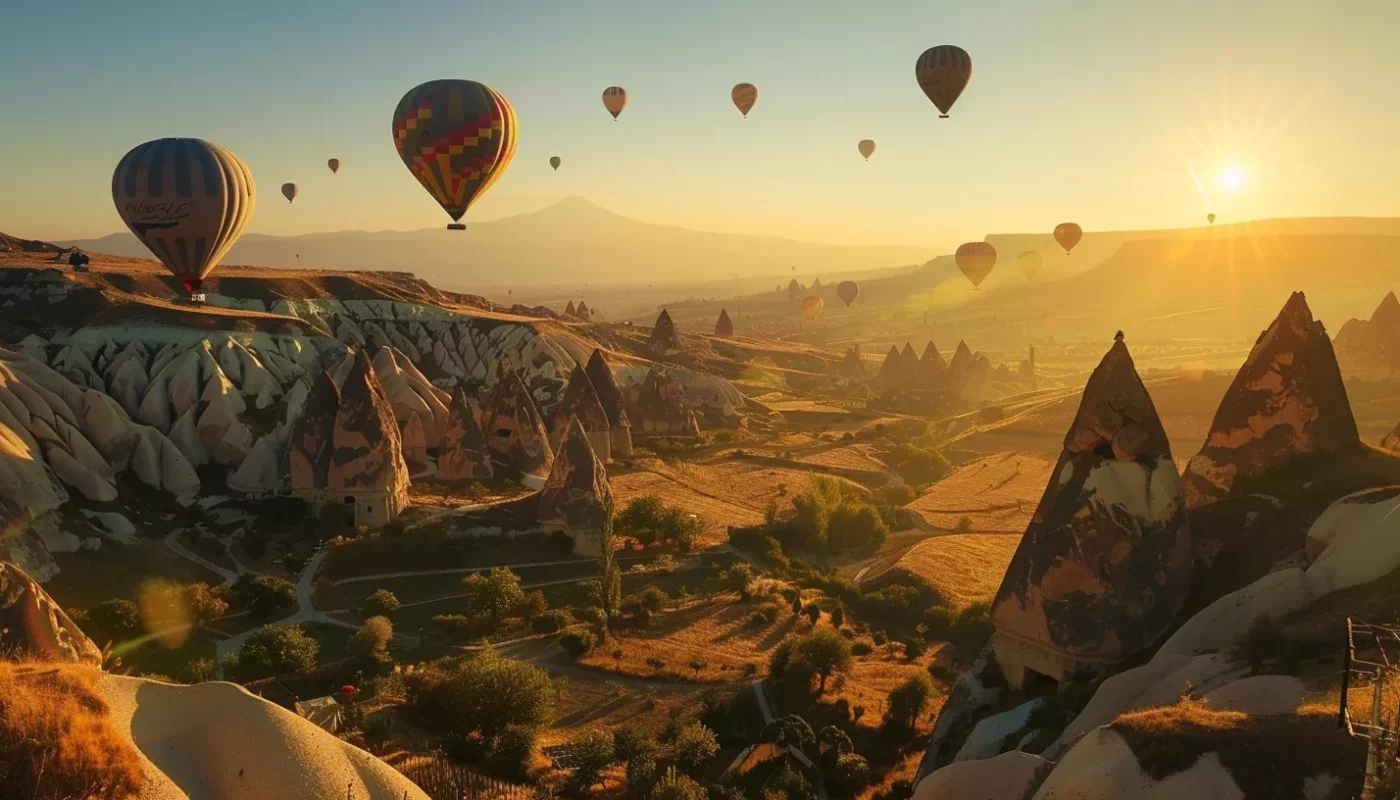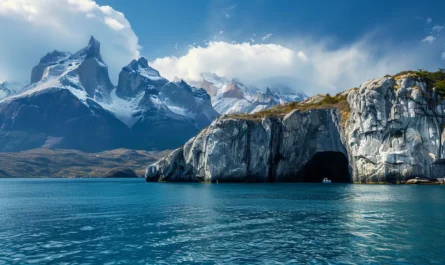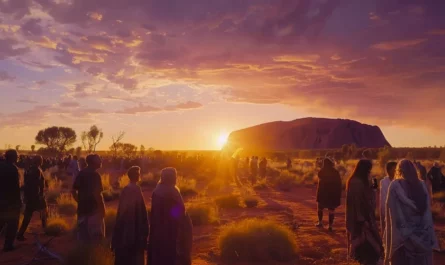Did you know fairy chimneys in Cappadocia were made over millions of years? This happened because of volcanic eruptions and erosion. These structures draw people worldwide with their stunning and mysterious beauty.
Cappadocia is in the Central Anatolia region of Turkey. It looks like it’s from a fantasy novel, with high plateaus and moon-like boulders. The fairy chimneys are made of soft tuff covered by harder basalt. Forces of nature shaped them into the beautiful sights we see. At sunset, they glow in colors from red to purple, making them unmissable on a trip to Turkey.
It’s crucial to keep these natural wonders safe. There are plans to preserve the chimneys and make sure tourism doesn’t harm them. Cappadocia is also a UNESCO World Heritage Site. It shows the power of nature and human history.
If you love geology, history, or just exploring, Cappadocia’s fairy chimneys are a must-see. They show how amazing nature can be.
The Enchanting Landscape of Cappadocia
Cappadocia, a region in central Turkey, is known for its unique and magical landscape. It’s a dream place for photographers, full of natural wonders. These wonders come from the mix of geography, volcanic activity, and erosion over millions of years.
Introduction to Cappadocia’s Unique Geography
The geography of Cappadocia features wide high plateaus and strange moon-like landscapes. It’s all because of the area’s volcanic history. The land has layers of volcanic rock, with soft tuff and hard basalt. Over time, wind and water have shaped this land into a dreamlike scene.
High Plateaus and Lunar-like Boulders
The high plateaus of Cappadocia show off nature’s beauty. The area has boulders and tall rocky pillars called fairy chimneys. These shapes come from the volcanic rocks and years of erosion. Cappadocia’s unique geography makes it look like a scene from the moon, sparking our imagination.
It’s important to protect Cappadocia’s beautiful landscape. Efforts to keep the balance between tourism and conservation help ensure future generations can enjoy its views. Cappadocia is a proof of the power of geological forces. It reminds us to appreciate and protect its beauty.
| Feature | Formation Process |
|---|---|
| Fairy Chimneys | Formed by volcanic rock formations and erosive processes over centuries. |
| High Plateaus | Result from the accumulation of volcanic sediments layered over millions of years. |
| Lunar Landscape | Shaped by ongoing erosion, resembling a lunar surface with unique rock formations. |
Geological Formation of Fairy Chimneys
Cappadocia’s fairy chimneys have a long history. They started forming millions of years ago, after big volcanic eruptions. These eruptions spread ash all over Central Anatolia. Then, the ash turned into a soft rock called tuff.
The Volcanic Origins
These rock formations have an interesting origin. Soft tuff was later covered by hard basalt layers. The basalt formed when lava cooled and became hard. This created a tough top layer over the soft tuff.
The Role of Erosion
Over a long time, wind and water shaped the land. They carved the tuff but left parts covered by basalt intact. Thanks to this slow erosion, the famous fairy chimneys came to be.
It’s crucial to keep protecting these wonders. By preserving the area, we ensure that future generations can also enjoy it. Conservation helps maintain the area’s natural beauty for years to come.
Historical Significance of Cappadocia
Cappadocia sits along the old Silk Route, linking the East and West. This path was crucial for trade and cultural exchanges. Many civilizations, like the Hittites and Byzantines, thrived here. They all added to Cappadocia’s rich history with their unique cultures and buildings.
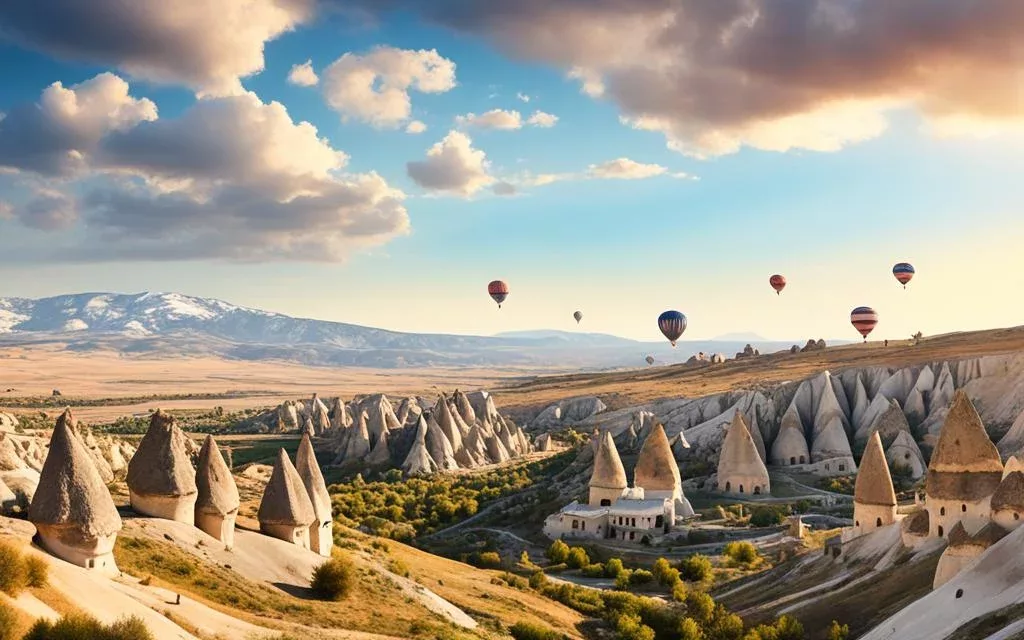
The Silk Route Connection
The Silk Route was vital for Cappadocia. It allowed the flow of goods, ideas, and people. This mix made Cappadocia a cultural hub. Ancient structures and local crafts today show the blend of cultural impacts. These exchanges brought wealth and cultural growth to the area.
Settlements Through the Ages
Cappadocia’s landscape let people build amazing underground cities. Derinkuyu is a great example of this creativity. These cities were safe havens and homes through time. This shows how Cappadocia has been a bustling place for centuries.
Preserving Cappadocia’s history is key. By declaring important places as UNESCO World Heritage Sites, we keep its wonders safe. This ensures future generations can enjoy Cappadocia’s heritage.
The Underground Cities of Cappadocia
The underground cities of Cappadocia boast amazing structures, like the famous Derinkuyu Underground City. They are vast networks below Earth’s surface. These caves were safe spots for people hiding from enemies long ago. They have many levels with rooms and tunnels.
The Hittites first made these caves, and later cultures added their touch. The Derinkuyu Underground City has living spaces, places to store food, wine cellars, and special spots for worship. Everything is linked together smartly, ready for living and protecting the community.
These cave homes also show how clever ancient people were at building, using natural rocks to make safe, lasting homes. Nowadays, saving these sites is key. We need to keep them standing strong while letting folks from all over see their beauty and learn their stories.
Cappadocia Fairy Chimneys: A Geological Marvel
The Cappadocia region is known worldwide. It draws millions of tourists every year with its unique landscapes and history. The fairy chimneys here are amazing. They show how wind and water can shape the earth.
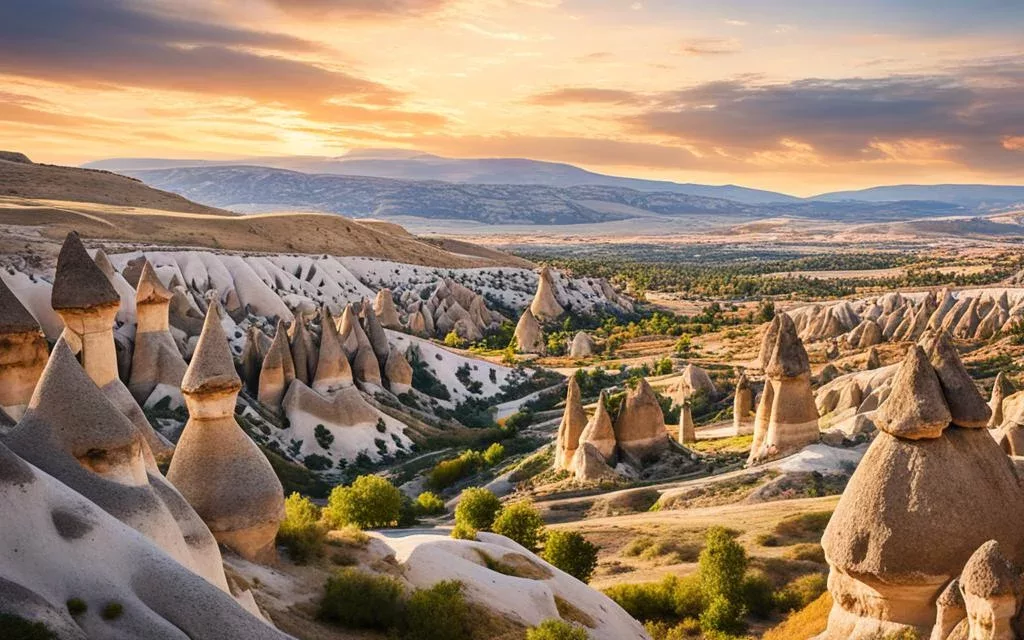
The Process Behind Their Formation
The making of the Cappadocia fairy chimneys is quite a story. It began about 30 million years ago with volcanic eruptions. These eruptions laid down ash that turned into tuff. Then, as the earth moved and erosion did its work, hard basalt formed on top.
Over millions of years, softer tuff was worn away by wind and water. This left striking hoodoo formations, capped with basalt. It’s a perfect example of nature’s artistry.
Distinctive Features of Hoodoos
The hoodoos in Cappadocia are remarkable, not just for their looks. They come in all shapes and sizes, and some are very tall. The mix of tuff and basalt is eye-catching. Plus, the tuff makes the soil fertile, helping local farmers.
This blend of beauty and usefulness makes the hoodoos very special. They attract both tourists and scientists from all over.
Keeping Cappadocia’s beauty and culture safe is very important. Being named a UNESCO World Heritage Site helped a lot. It led to efforts to protect these natural wonders while keeping tourism going. This way, the fairy chimneys can be enjoyed by many more people in the future.
| Geological Processes | Impact |
|---|---|
| Volcanic Eruptions | Formation of tuff layers from volcanic ash |
| Tectonic Movements | Shaping the landscape and creating plateaus |
| Erosion | Sculpting hoodoos and unique rock formations |
Learn more by checking out the awesome details on Cappadocia’s geological wonders.
Exploring Cappadocia: Adventures Await
Cappadocia is perfect for adventure-lovers. It offers exciting activities against a stunning backdrop. Travelers of all kinds can enjoy hikes, bike rides, horse rides, or flights through the skies here.
Hiking Through Sword Valley
Start an amazing hike through Sword Valley. It’s a haven for adventurers. You’ll see fairy chimneys up close on rugged trails. It’s ideal for those who love nature and challenges.
Mountain Biking and Horseback Riding
There are many mountain biking and horse riding paths in Cappadocia. Bikers will love the varied landscapes they’ll pass. Horseback riding offers a traditional experience, echoing the journeys of ancient travelers.
Paragliding Over Valleys and Spires
Paragliding in Cappadocia is exhilarating. You’ll fly over beautiful valleys and spires for a unique view. It’s an adventure that combines excitement with stunning scenery, especially at sunrise or sunset.
We must protect this beautiful landscape for the future. There is ongoing work to keep Cappadocia’s natural and historic sites safe. This ensures adventures can be enjoyed by generations to come.
| Activity | Best Experience | Recommended For |
|---|---|---|
| Hiking in Sword Valley | Iconic fairy chimneys | Nature enthusiasts, seasoned hikers |
| Mountain Biking | Challenging trails with scenic views | Adrenaline seekers, cycling enthusiasts |
| Horseback Riding | Traditional exploration, scenic routes | History buffs, equestrian enthusiasts |
| Paragliding | Aerial views of valleys and spires | Thrill-seekers, photographers |
Human Habitation in Fairy Chimneys
Cappadocia’s unique geological formations have captivated many and provided homes for various civilizations. These formations, known as fairy chimneys, are crucial to the region’s human history.
Early Settlements and Troglodyte Villages
The Hittite era’s early settlers carved homes in the soft tuff rock. They created extensive troglodyte dwellings within these rock formations. These homes offered insulation, protection from invaders, and shelter from the harsh climate.
Over time, these cave communities evolved. They added living rooms, kitchens, and chapels inside the fairy chimneys.
Byzantine Churches and Frescoes
The Byzantine era’s impact is seen in Cappadocia’s remarkable cave churches. These churches show Cappadocia’s rich history and Christianity’s spread. They are adorned with beautiful frescoes, showcasing Byzantine architecture’s intricate details.
Among these, the Göreme National Park cave churches stand out. They are known for their art and religious importance.
Conservation efforts are crucial for protecting these historical sites. Keeping these dwellings and churches safe helps us learn from ancient civilizations. It shows the blend of Cappadocia’s history and its geological wonders.
Rediscovery and Preservation Efforts
Cappadocia’s allure goes beyond its mystical landscapes, deep into a rich history. The underground cities, especially Derinkuyu, were uncovered in the 1960s. This discovery revealed a network of tunnels and rooms.
It showed how ancient people survived using clever strategies. They built incredible underground spaces for protection.
The Discovery of Derinkuyu
A local found Derinkuyu by chance while fixing his house. He discovered a hidden room that led to more rooms deep underground. This sparked new interest in Cappadocia’s past.
The city’s design, with its shafts and rooms, shows human cleverness. It reflects how people adapted to challenges to survive.
UNESCO World Heritage Designation
In 1985, Göreme National Park and Cappadocia’s rock sites got UNESCO recognition. This was crucial for their care and for promoting tourism that respects history. UNESCO’s work helps keep Cappadocia’s beauty and history alive.
Tourism and preservation work together here. Historic fairy chimneys and caves are now unique hotels. This lets visitors truly experience Cappadocia’s heritage.

